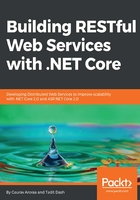
Summary
REST defines how to use the uniform interface through additional constraints, how to identify resources, how to manipulate resources through representations, and how to include metadata that makes messages self-describing.
The web is built on HTTP’s uniform interface, and the focus is on interacting with resources and their representations. REST isn’t tied to any specific platform or technology; the web is the only major platform that fully embodies REST. The basic style of the architecture of RESTful web services is client–server.
Here, the client requests a resource and the server processes and responds to the requested resource. The response of the server is user-based and platform-independent. The separation of concerns is the principle behind the client–server constraints. Because in client–server architecture, the storage and user interfaces are roles taken by the server and client respectively, it has improved portability of the user interface across multiple platforms.
We should document every resource and URI for client developers. We can use any format for structuring our document, but it should contain enough information about resources, URIs, available methods, and any other information required for accessing the service.
Swagger is a tool that can be used for documentation purposes, and provides all the information regarding the API endpoints on one screen, where you can visualize the API and test it by sending parameters as well. Developers can use another tool called Postman for testing out APIs. Both of these tools will be explained with examples in the upcoming chapters of this book.
ASP.NET Web API is a development environment constructed to develop RESTful web services that allow applications to send and receive HTTP requests (web requests) easily and perform operations based on the types of requests that are made to it (such as providing information about a user when given their ID, and so on).
Web API design in ASP.NET Core has been simplified following the same programming model as MVC.
In the next chapter, we will start coding by setting up the environment and look into the various fundamentals of the HTTP verbs in Web API.